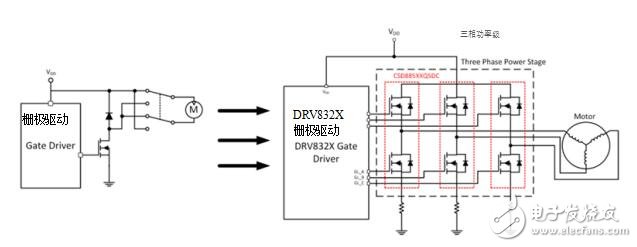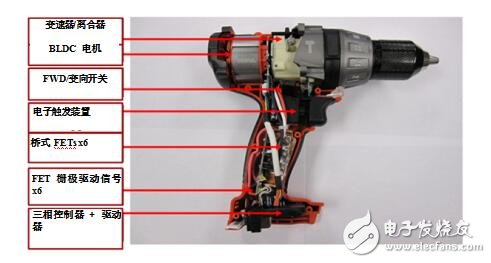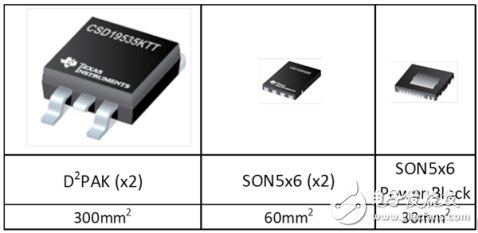The priority configuration of DC motors in power tools has shifted significantly from brushed DC to a more reliable and efficient brushless DC (BLDC) solution. A typical brushed DC topology such as a chopper configuration typically implements one or two power metal oxide semiconductor field effect transistors (MOSFETs) depending on the use (or no use) of the bidirectional switches. On the other hand, a three-phase BLDC configuration requires three half bridges or at least six field effect transistors (FETs), so switching from brushed current to brushless current means 3 to 6 times the global market for power tool FETs. see picture 1). As a member of TI's NexFETTM power MOSFETs, it's hard to complain about this market trend.

Figure 1: Conversion from brushed to brushless topology means six times the number of FETs multiplied
But the BLDC design proposes new technical requirements on these FETs. For example, if the number of FETs on the board is multiplied by 6 times, which means that the printed circuit board (PCB) footprint required to drive the motor is increased by a factor of six, the BLDC design is unlikely to be suitable for power tool and garden tool manufacturers. Keep in mind that power electronics are usually located in the handles of these tools; therefore, to accommodate the smallest hand size, applications are often extremely space limited (see Figure 2). Solutions that require higher power densities, in other words, require FETs that can handle more current in a smaller space.

Figure 2: In most power tools, the electronics are in the handle
Traditionally, FETs for driving high-power motors have large and heavy packages, such as TO-220, DPAK, and D2PAK. But newer quad flat no-lead (SON) 5mm & TImes; 6mm FETs such as the updated quad flat no-lead (QFN) package provide a smaller package resistance between the silicon and source pins. A small resistance per unit area means less conduction loss per unit area, which means higher current capability and higher power density. As a result, as the resistance per unit area of ​​the FET silicon (RSP) continues to drop (roughly half of that of each generation in the past), it is not surprising that QFN solutions for the power tools, gardening tools, and home appliances industries are growing rapidly. These smaller FETs are now typically capable of self-driving DC motor currents of up to 30A or higher; even for higher power designs, paralleling multiple QFNs is sometimes more suitable for larger packages. After all, the two 5mm & TImes; 6mm devices still only occupy a small part of the D2PAK in the total PCB area of ​​60mm2, which is about 10mm × 15mm, or 150mm2 in the total PCB space (see Figure 3).

Figure 3: PCB space required for a half bridge (not drawn to scale)
TI recently attributed this trend to a logical conclusion by integrating the two FETs vertically into a single package, providing the entire half-bridge in a SON 5mm x 6mm power module. The 40V CSD88584Q5DC and 60V CSD88599Q5DC use the same stacked die technology as TI's low voltage power blocks for high frequency power applications, but with optimized silicon to reduce conduction losses in high current motor drive applications. In addition to minimizing the parasitic inductance of the two FETs side by side on the PCB, the vertical integration of two FETs can accommodate more silicon in the same package, resulting in higher power density than discrete QFN devices.
These devices also feature a thermally enhanced DualCoolTM package with a bare metal top. Therefore, although there are still some cases where power tool manufacturers may prefer to use TO-220 FETs for surface mount FETs, because these FETs can be mounted on large heat sinks to remove heat from the PCB, these power modules are used. The QFN package offers the same benefits. For example, even in the most ideal thermal environment, it is generally not encouraged to dissipate more than 3 W of power in a typical 5 mm x 6 mm QFN. But with proper use of heat sinks, these DualCool devices can handle 6W or more of power consumption, doubling power density and reducing PCB footprint by half.
Power density is synonymous with gaming today when it comes to the introduction of the more popular BLDC motors in power tools, garden tools and battery-powered home appliances. TI's new power module solutions achieve this goal at an unprecedented level.
other information· For more information on these new power modules, please see the high power density brushless motor driver reference design with 18V / 1kW, 160A peak and 40% efficiency with 40V CSD88584Q5DC.
· Order the DRV8323RH three-phase intelligent gate drive evaluation module with 60V CSD88599Q5DC and DRV8323R gate drivers.
Wall Box And Outlet,Wall Box Outlet,Electrical Box Outlet,Electrical Box Vs Outlet
Huizhou Fibercan Industrial Co.Ltd , https://www.fibercan-network.com